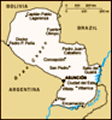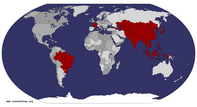Advertisement
Published: October 27th 2014
It was not planned but once in Foz de iguacu, Brazil, we (my parents and I) ended up crossing borders and having a glimpse at Argentina and Paraguay. 3 countries in 2 days without planning it, without driving all day, and without flying! When will we ever do this again?
In Foz, we were extremely lucky to be invited to stay at the local Cycling Club HQ where our new friend Ricardo took really good care of us. Ricardo showed us around town; he took us to the Argentine border on day 1 when we thought we’d be able to access the Iguacu Falls in spite of the floods. And on Day 2 Ricardo took a day off to drive us to Paraguay to have a look at the tri-borders (la triple frontera) between Brazil, Argentina and Paraguay. This is where the Iguazu and Parana rivers merge. At the convergence of the borders, each of the three countries has erected some kind of monument, painted in the national colors, from where visitors can observe the river banks on the Brazilian, Argentinean and Paraguayan side. After the torrential rains (did you see my last blog on the Iguazu Falls?) we were
pretty amazed by the water levels. The next day we read that 160,000 people in Paraguay were affected by the floods.
Ricardo knows the area very well so he took us through the countryside and we got to see more waterfalls (impressively overflowing), and some smaller towns and villages. People in Paraguay seemed extremely friendly and easy-going. We stopped near the river to look at how high the water had got over night. People were paddling over what used to be the road. We chatted with a few locals and were invited to taste the local
mate: it’s a caffeine-rich infused drink, prepared by steeping dried leaves from a rainforest tree (called
yerba mate) in hot water. Later on Ricardo stopped at a bakery for us to enjoy some local meat snacks (in some kind of fried dumpling).
There was no immigration office at the Brazil-Paraguay border and Ricardo assured us that we didn’t need to stop to get stamped in. We slowly drove through what looked like a toll gate with a few policemen standing on each side, observing the car flow. And nobody stopped us. Except… a couple of hours later some random cop organizing traffic
outside a village must have noticed Ricardo’s Brazilian license plates and he stopped us over. Ricardo immediately got really nervous because we didn’t have any entry stamps on our passports. Ricardo started talking and talking and blabbering non-stop to the policeman about the flood and how incredible it was, and how we had to come and see it because it never happens… Then the officer looked at my parents and I and asked to see our passports… F%*#! I reluctantly gave mine as my parents smiled and acted as if they had no clue what was happening. I think eventually we were very lucky that I gave him my passport only, because it’s almost full and it’s not easy to find a precise stamp since there are similar stamps on 50 pages. I think the cop got overwhelmed and after flicking through a few pages, he just gave it back and told us to get going. My parents just renewed their passports before the trip so they only had the Brazil stamp in. I’m very glad he didn’t ask for theirs. Ricardo let out a sigh of relief. He was so tense but we can laugh about it now.
We only spent a day around Ciudad del Este in Paraguay but we couldn’t help notice a pretty big difference between Brazilian and Paraguayan infrastructures: potholes on the road, old-looking (unfinished?) football stadium, torn down sidewalks, no flashy car, but very colorful old buses! Many people actually rode motorbikes. However, right after the border crossing there are a few big department shops and it looked like many Brazilians were doing their grocery shopping there. Heaps of people were going back to Brazil on foot carrying lots of grocery bags.
We also spent some time at the Itaipu Dam, 14km north of Foz de Iguacu (in Brazil), which trades unbelievable stats with the Three Gorges Dam in China for largest hydroelectric power plant on the planet accolades. I will copy what my Lonely Planet guidebook states: “
the dam structures stretch for almost 9km and reach a height of more than 200m. The concrete used in its construction would be sufficient to build a two-lane highway from Moscow to Lisbon. At the height of construction, crews worked at a blinding pace, equivalent to building a 20-storey office building every hour. No wonder it cost US$18 billion. The plant provides 22%!o(MISSING)f the electric energy consumed in Brazil, and more than 90%!o(MISSING)f the energy consumed in Paraguay. Even more extraordinary is the massive size of the construction that spans the river, the palpable power of the water rushing out of the spillway, and the endless array of power lines emanating from the plant.”
- The Iron and steel used in the construction of the Itaipu Dam would be enough to build 380 Eiffel Towers.
- The total volume of concrete used in the construction of the plant would be enough to build 210 football stadiums like the Maracana in Rio.
- If Brazil were to obtain the energy generated by Itaipu through oil-fueled thermoelectric plants, it would be necessary to burn 536,000 barrels of petroleum per day.
- 700 square kilometers of forest was lost or compromised in the construction of the dam.
We left Foz de Iguacu on June 10. We truly hope to see Ricardo in France in the next few years (to watch the Tour de France?). It was another long drive on BR 277 to reach Ponta Grossa as we wanted to visit Vila Velha National Park (next blog). Due to flooding,

 We are in Paraguay!
We are in Paraguay!
The Chirons are traveling!we met massive traffic congestion on several occasions. We ended up spending the night in the car… again!
A Foz de Iguacu, nous avons loge chez notre nouvel ami, Ricardo, qui s’occupe du club cyclo-touriste en ville. Il a pris une journee pour nous emmener au Paraguay. Nous avons traverse la frontiere dans sa voiture, sans prendre le temps de faire tamponner nos passeports… Ricardo nous a assure qu’il n’y avait pas de controle ici. Apres la visite d’une nouvelle belle chute d’eau, bondee après les pluies torrentielles qui se sont abattues sur la region, nous nous sommes promene le long du fleuve Parana qui se joint au fleuve Iguacu. A la jonction des 2 fleuves, nous nous trouvions au Paraguay, a admirer les 3 frontieres: l’argentine d’un cote, le Bresil de l’autre.
Au premiers abords, les infrastructures du paraguay etaient en moins bon etat qu’au Bresil. Les routes nous ont paru beaucoup plus petites et bosselees; les trottoirs etaient defonces. De l’exterieur, le stade de foot d’une grosse equipe pro faisait peur a voir… Nous n’avons pas vu de grosses voitures comme au Bresil. Beaucoup de Bresiliens semblent traverser la frontiere pour faire leurs courses
du cote paraguayen.
Nous avons goute le
maté, une infusion traditionelle a base de feuilles de mate (un arbuste proche du houx), riche en caffeine (que les Indiens d’Amerique Latine consomment depuis des siecles). Cette plante est utilisee pour augmenter le flux urinaire et soulager les sensations de fatigue. On a egalement deguste quelques snacks a base de viande et de pain. Les paraguayens que nous avons rencontres nous ont paru charmants, souriants, et detendus.
Et puis au milieu de nulle part, sur une petite route de campagne, un policier s’est mis au milieu de la route et a fait signe a Ricardo de s’arreter. En une fraction de seconde, on a tous stresse, Ricardo le premier, car nous sommes rentres au Paraguay sans nous declarer. Ricardo, d’une voix stressee, a tente de la jouer sympa et il s’est mis a parler des innondations, et a quel point c’etait incroyable, et rarissime, mais que ca valait vraiment le coup d’oeil… mais son long monologue n’a rien change et le policier a demande a voir nos papiers… Je lui ai donne mon passeport avec reticence et un sourire crispe… Le policier n’a pas du voir beaucoup de passeprts comme
le mien, rempli de visas en tout genre et d’autres tampons dans pleins de langues differentes. Je crois qu’il n’a pas ete capable de comprendre ni d’ou l’on venait, ni si l’on avait un tampon bresilien, paraguayen ou autre, il a fait une grimace et nous a rendu le document en nous demandant de circuler! Ouf! Ricardo a laisse echappe un long soupir de soulagement et un grand éclat de rire! Je crois qu’on peut s’estimer chanceux. Les passeports tout neufs de mes parents auraient ete beaucoup plus faciles a lire avc un seul tampon bresilien a l’interieur…
Et puis nous avons aussi visite le barrage d’Itaipu qui est l’une des 2 plus grandes centrales hydroelectiques au monde. J’ai retenu quelques chiffres records… Le barrage s’etend sur 9km et fait jusqu’a 200m de haut. La construction du barrage a necessite autant d’acier que si l’on construisait 380 Tours Eiffel. Avec tout le ciment qui a ete utilise sur le barrage, on pourrait construire 210 stades de football comme le Maracana de Rio. Si le Bresil devait generer autant d’energie que le barrage d’Itaipu produit aujourd’hui, il faudrait bruler 536,000 barils de petrole par jour. 700 kilometres carres

 Itaipu Dam
Itaipu Dam
the dam structures stretch for almost 9km and reach a height of more than 200m. de foret ont ete detruit par la construction du barrage. Le barrage fournit 20% de l’electricite du Bresil et 90% de l’electricte necessaire au Paraguay.
Nous avons quitte Foz de Iguacu le 10 juin en remerciant Ricardo, qui devrait en principe nous rendre visite en Europe dans les annees a venir (pour assister au Tour de France?).
De notre cote il nous fallait a nouveau parcourir 1100km en voiture (visite d'un parc national au passage) et ne pas se perdre dans la jungle urbaine de Sao Paulo avant de pouvoir assister a la Fan Fest pour le match d'ouverture de la Coupe du Monde! A suivre! Bises
Advertisement
Tot: 0.102s; Tpl: 0.018s; cc: 14; qc: 33; dbt: 0.0424s; 1; m:domysql w:travelblog (10.17.0.13); sld: 1;
; mem: 1.1mb























taracloud
Tara Cloud
Powerful!
Incredible force of this water! When I visited the Tri-Border area, there was so much more land and placid, lazy rivers compared to that in your panorama. Your photos say June, which is supposed to be the dry season, so this is really a climate reversal! Well-told story of you, Ricardo and the policeman--very funny. Glad you escaped, you border jumpers!